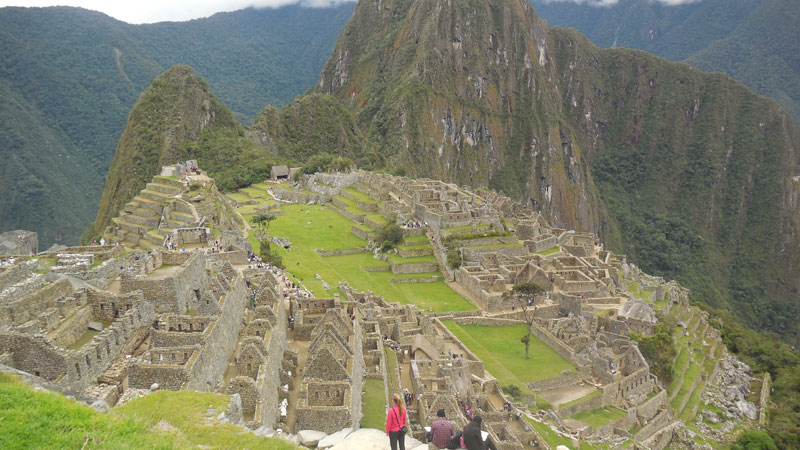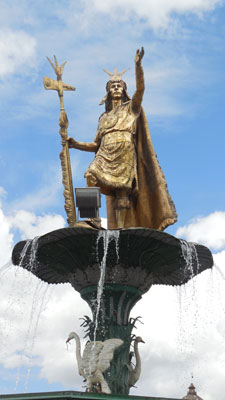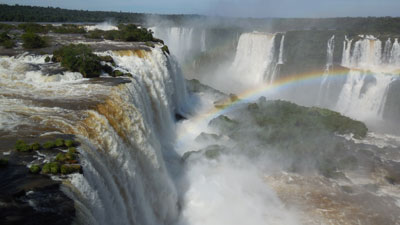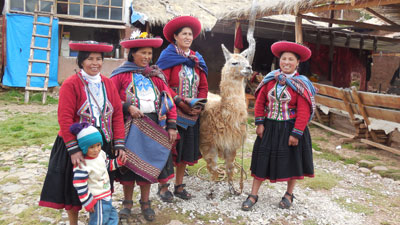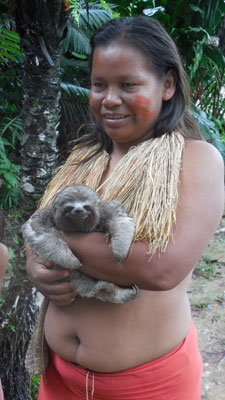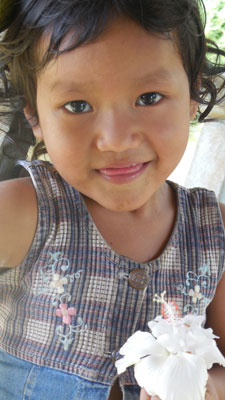Waterfalls, wildlife and wondrous sights on a South American adventure
This article appears on page 6 of the November 2014 issue.
by Sharon VanDewark; San Diego, CA
¡Simplemente una maravilla! How many times would I say those words — an exclamation meaning “Just wonderful!” — on my spring 2014 trip to South America? Many! They applied to the lofty “Christ the Redeemer” statue in Rio; Iguaçu Falls, bridging Brazil and Argentina; Machu Picchu in Peru, and my adventures in the Amazon.
Arriving in Rio
I left southern California on March 22 and flew, via American Airlines, to Rio de Janeiro. There I met tour director Luis Mendias and my fellow travelers for Go Ahead Tours’ “Grand Tour of South America.” Luis, who speaks seven languages, proved to be an excellent guide.
It wasn’t long before I could feel the beat of the samba music and was dipping my toes in the sand of Copacabana Beach.
Our accommodations at the Golden Tulip Regente (Avenida Atlantica, 3716), located directly across from Copacabana Beach, were excellent.
That afternoon, our group took the Corcovado Rack Railway through Tijuca Forest National Park to the top of Corcovado Mountain to see the 98-foot-tall (not counting its 26-foot pedestal) “Christ the Redeemer” statue. Built between 1922 and 1931, it has aged well. (A finger on the statue’s right hand was hit by lightning during a storm in January 2014 but had already been repaired.)
The next day we took a cable car to the top of Sugarloaf Mountain and were treated to incredible views of the beaches, the ocean and other areas of Rio.
An incredible experience
From Rio we took a 1½-hour LAN Airlines flight to Brazil’s Iguaçu Falls airport. Our hotel, Mabu Thermas Grand Resort (Av. das Cataratas, 3175 Foz do Iguaçu), was just beautiful. There were four outdoor swimming pools, a tennis court, a lake and walking paths through extensive gardens of hibiscus and bougainvillea, and the hotel’s breakfast and dinner buffets were extensive.
The next morning some members of our group took a short ride to the helicopter port for a flight over one of the largest waterfalls in the world, Iguaçu Falls. It was breathtaking to see them and spectacular to see the thousands of miles of jungle surrounding them. It was over much too soon.
“Iguaçu” (or Iguazú) is derived from a word meaning “Big Waters” in the Guarani language. The falls are situated in both Brazil and Argentina, but helicopters fly from the Brazilian side only. A smaller percentage of the falls lies on the Brazilian side, but that is the best side for viewing.
A bus took us to walkways that led us along the ¾-mile-long path to the falls. Try to picture being surrounded by wild water rushing and swirling under and around you. The roar of the falls could soon be heard, and the blowing mist left a lot of us very wet. (Ahhhh! I can still feel it!) It was so incredible that there aren’t enough adjectives to describe it all!
At the end, there was an elevator to take visitors higher for even more incredible views.
In the wet season there are approximately 275 separate falls that comprise Iguaçu and in the dry season, 150. Because of the strong overspray, a poncho or raincoat is a necessity — but, even with that, I got soaking wet. (No umbrellas due to the wind.)
The walkway, which extends way out over the water, offers the most breathtaking views. From the end of the walkway you can see Devil’s Throat (on the Argentinian side), which has a drop of 269 feet. Seeing the power of so much water spilling over the cliffs was simplemente una maravilla!
Coatimundis, small but powerful mammals in the raccoon family, are often seen near the eating area, so we were warned not to approach or feed them, as they can bite.
On to Argentina
We were now ready to go to the Argentinian side of the falls. We had to produce proof that we had paid the $160 reciprocity fee, which must be done before leaving the US, before we entered Argentina.
We took an “eco-train” (natural gas) from the park entrance to Devil’s Throat. From there, it was a one-mile walk on the steel-grate walkway to see the falls from different angles.
We saw many double rainbows; our guide said we were lucky because that happens infrequently.
The shutterbugs in our group had a field day with the beautiful scenery. We were not rushed and had time to take all the photos we wanted. There was also time to buy postcards before we had to return to our hotel for the afternoon and evening.
In the morning we flew to Buenos Aires with LAN Airlines. Our hotel, the NH Lancaster (Av. Córdoba 405), was in an excellent location, just two blocks from the 3-story Gallerías Pacífico indoor mall at the intersection of Córdoba and Florida streets.
The mall has beautiful murals on the walls and ceiling plus many restaurants and fast-food places as well as a Freddo ice cream shop (delicious mint-chocolate chip ice cream).
Florida Street, running beside the mall, is a pedestrian-only street with endless shops and stores selling just about anything. I walked about three-fourths of a mile and felt perfectly safe.
I wandered into a small shop to purchase some leather wallets and small clutches. The lady in the shop spoke little English (about as much as I speak Spanish), but her friendliness was amazing. I left with a smile and five leather purchases.
Touring Buenos Aires
We took a city tour and stopped at the intriguing La Recoleta Cemetery, where Eva Perón is buried. The tombs there were so fascinating that I walked back the next day to revisit this “mini city.”
Being a dog lover, I especially enjoyed one tomb. It was that of Liliana Crociati de Szaszak, who had been killed by an avalanche in 1970 in Innsbruck, Austria. The tomb featured a statue of Liliana in her wedding dress, her hand resting on the head of a bronze statue of her dog, Sabú, which was added after his death. Very touching! (Sabú’s nose is all shiny from everyone touching it.)
Our afternoon was a busy one, including a tour of the La Boca neighborhood, where the tango was born. What an interesting place to walk around in, with myriad multicolored houses and buildings! There were fun statues of tango dancers on balconies and, of course, the sounds of tango music being played — colorful, colorful, colorful and utterly delightful. ¡Simplemente una maravilla!
That evening we dined at a typical Argentinian barbecue restaurant, the meat cooked on vertical skewers over glowing coals. My steak was perfectly cooked.
The next night we went to an excellent tango show with dinner at Café de los Angelitos (Av. Rivadaria 2100; www.cafedelosangelitos.com). It was very entertaining, interesting and fun.
Continuing to Cusco
Leaving very early the next morning from Buenos Aires, we arrived at Cusco’s Alejandro Velasco Astete International Airport after a 1½-hour flight. Called the “city of stone,” Cusco was the historical capital of Peru and is now a UNESCO World Heritage Site.
We were advised several times by our guide to “slow down... take it easy” once we arrived in Cusco, as it sits at about 11,200 feet in altitude.
I did not take any altitude sickness medication and felt fine. However, others on our tour were not as lucky and stayed in the hotel because they did not feel well.
At our hotel, there was a basket of coca leaves and coca tea bags for guests to make tea; the coca leaf is a mild stimulant that is said to help with altitude sickness. I tried a cup of tea but did not notice any change. Eating wisely and drinking lots of bottled water also helps.
Our hotel, Hotel José Antonio Cusco, was only a 10-minute walk from the Plaza de Armas, in the city center. We had time to “settle in,” so I decided to walk to an artisanal market, located on the other side of very busy street. Prices there were very low, and there was a good variety of items, not to mention the very friendly people.
The churches of Santo Domingo and La Compañía de Jesus, the latter built in the 1500s after the Spanish conquistador Francisco Pizarro conquered Cusco, are both located on the Plaza de Armas. On many of the city’s streets you can see the foundations of precisely fitted Incan stones with newer buildings built on top — amazing when you consider all the earthquakes Cusco has suffered.
A “must see” for visitors is the Temple of the Sun, Qurikancha (also spelled Coricancha). Dedicated to the sun god, Inti, it was the most important temple in the Inca Empire. Although it is now only ruins, 500 years ago it had floors and walls covered with sheets of gold plus a large disc, plants and 20 life-size llamas and herders and other statues all made of solid gold.
The temple was destroyed by the Spanish conquistadores, and Spanish colonists built the Church and Convent of Santo Domingo on the site, using the tightly fitted blocks of stone for the foundation.
On the northern outskirts of Cusco lie the ruins of Sacsayhuamán, constructed of massive stones, some weighing hundreds of tons, all fitting together precisely without mortar or cement. The giant blocks were shaped using only river stones or rock hammers, and it is said that you cannot even slide a cat’s whisker between the blocks. ¡Simplemente una maravilla!
Many of the walls were destroyed in the 1500s when the smaller stones were used to build houses in Cusco. The giant ones were left behind at Sacsayhuamán.
Into the highlands
The next morning we were on our way through the lovely Peruvian Highlands. Our first stop was a weaving co-op of 12 families at Chinchero. We met a lady dressed in traditional Peruvian style — full skirt, sandals, embroidered blouse and red felt hat — who had walked an hour to get there. As members of the co-op walk, they are constantly spinning wool onto spindles. (I saw many ladies doing this.)
They showed us how they use various plants, minerals, seeds, insects, leaves, etc., to make their dyes. It was very interesting, and we even had a cup of tea while watching. Afterward, we had a chance to look at all the beautiful items they had woven. Unfortunately, most of the items were made from alpaca hair and were too warm for southern California.
They also sang songs for us, and we posed for photos with Pancho, the resident llama.
Continuing on in the Sacred Valley, we came to Ollantaytambo, another important archaeological site. A high fortress of many terraces, it has many stone steps. Walking up approximately 19 terraces of steps was a good introduction to the climb we would be doing the next day at Machu Picchu (multiplied many times, but, oh, it would be worth it!).
The view from Ollantaytambo stretched far across to the distant mountains.
We stopped in Urubamba at Hacienda Alhambra (Calle Sagrado) for a delightful lunch buffet under outdoor gazebos. There was a good selection of buffet items, but the highlight — the very best part — was when a herder brought his alpacas, llamas and vicunas to the grass in front of us for their own “grass buffet.” The antics of a 4-month-old baby alpaca were fun to watch.
Machu Picchu
In Aguas Calientes we checked into Hotel El MaPi (Av. Pachacutec 109). My complimentary pisco sour before dinner was nice.
The town of Aguas Calientes was quite small and very clean, but it was constantly busy with tourists headed to Machu Picchu, less than five miles away.
There were all kinds of restaurants available, just a walk away up or down the sloping sidewalk, and there were several tourist markets. Our hotel restaurant had a wonderful buffet with many choices.
The next morning we boarded a small bus and rode to the entrance of Machu Picchu. (The price was included in our tour.) Be sure to carry bottled water and sunscreen, which are necessities.
The road to Machu Picchu was mostly switchbacks and so narrow that when we met an oncoming bus, either we or they had to stop and let the other one pass. It was only a 30-minute ride along the Urubamba River, but the road was very windy. In many places it was made of cobblestone and very bumpy.
Finally we were about to arrive at the crown jewel of South America: Machu Picchu. The mountaintop citadel was built in 1450 and abandoned 120 years later. Since this area is a cloud forest, it took only three years for the trees, brush, moss and vines to completely cover the mountainside, making the fortress disappear for more than 300 years.
Hiram Bingham, an American historian who was traveling through the Sacred Valley, “rediscovered” it with the help of a local farmer. In 1983, Machu Picchu was declared a UNESCO World Heritage Site.
Machu Picchu has a central plaza, many reconstructed buildings, a residential area, long, long stairways with no railings and a section for religious and ceremonial purposes. The intricately fitted granite stones that make up the walls were awesome. They had been well preserved for nearly four centuries by being hidden under the fast-growing shrubbery, vines and trees.
The hillsides were terraced to prevent erosion and landslides but also to grow crops. There were channels to provide irrigation for the fields. The many stone stairways provided access to the upper levels.
Restoration and preservation is an ongoing process there.
You could spend many hours exploring the site, walking all the staircases up and down the mountainside. It is a wondrous place; you’ll need time to reflect on how glorious it is.
All too soon we had to go back down the mountain to Aguas Calientes and head back by train to Ollantaytambo and on to Cusco.
Lima
The next day we flew to Lima via LAN Airlines. (Some travelers left for home at this point.) The rest of the group and I stayed at Hotel José Antonio Lima (Av. 28 de Julio, 398), located in the Miraflores district. They have an airport shuttle and free WiFi.
Colonial buildings and churches around Lima’s Plaza Mayor displayed Moorish influence in their architectural details and many beautiful carved, enclosed balconies. We stopped at the President’s Palace but were warned by the guards, “One photo only.”
The Cathedral on the Plaza Mayor contains the tomb of Francisco Pizarro, who conquered the Inca Empire. He was murdered in 1541. The 16th-century cathedral has three main doors, its central portal called Portada del Perdón, or Door of Forgiveness.
Inside, there are many side chapels, one containing a very unusual black altar.
Continuing our walk in the Plaza Mayor (aka Plaza de Armas), we saw the Archbishop’s Palace, with its Moorish balcony. The colonial-style buildings downtown were mostly painted a bright yellow. When I asked why, I found out the name “Lima” was derived from an Aymara word meaning “yellow flower.”
On the way back to the hotel we stopped at Parque del Amor (Park of Love) in the Miraflores area. There you can see benches similar to those designed by Antonio Gaudí in Parc Güell in Barcelona. Bits of tile were used to form poetry and quotations about love and to create images of flowers and clouds.
Amazon accommodations
Next we flew to Iquitos in the Amazon, the final stop in our grand tour of South America. Iquitos was hot and humid, but it was so interesting that the heat did not bother me.
From the airport, a bus took us to the dock downtown for our boat trip to the lodge where we were staying, Ceiba Tops Lodge, located 25 miles downriver on the Amazon. That was the first time I had taken a boat to get to a hotel.
It took about 45 minutes to arrive at the lodge, but it was a fun, breezy ride in the open-sided boat. The spray from the river felt so good in that humid climate.
Ceiba Tops is located right in the jungle. The cottages where we stayed were only feet from the milk-chocolate-brown waters of the Amazon River, lush with tropical plants, flowers, epiphytes (aerial plants) and trees. I had never seen so many blooming heliconia, which, as our guide showed us, you can “milk” to create a kind of lotion used by the natives.
As I walked on one of the lodge paths I was, all of a sudden, introduced to the Amazon wildlife. Five feet away from me was a tapir! He looked like a giant black pig, and with his snout he was pushing a metal water faucet pipe up and down. He walked away, came back, opened his big mouth and pulled on the pipe. It came loose and the water shot into his mouth. He took a long, long drink of water, then ambled away. (I then went to the office and told them that the water was making a waterfall.)
A few final adventures
That afternoon we took a walk deep into the jungle with Percy, our guide. We stopped at a ceiba tree that had a super-long vine attached to it with a loop at the end for sitting or standing. I stood on it and, with a push from Percy, was able to swing high à la Tarzan. ¡Simplemente una maravilla!
In the morning, a motorboat took us five miles along the Amazon to visit an indigenous Yagua tribe. As we approached, one of the girls handed me a baby sloth to hold. That was a first for me!
Our guide said there were seven families there with 21 children among them. The girls and women all wore short red skirts, and the women had dried grass coverings on their chests. We joined them in a dance inside a large thatch-roofed hut, and the men demonstrated how to use a blow-dart gun by aiming at a post about 15 to 20 feet away. I hit it on the first try! There also were crafts for sale.
When we returned to our lodge, I headed for the “longhouse,” or hammock house. It had open sides and there were several hammocks inside. I stretched out in one of the hammocks, reminiscing on all the wonderful things I had seen and done over the past two weeks.
That afternoon our guide took us out on one of the tributaries of the Amazon and we fished for piranha. I caught three and our guide caught five. The hotel cooked them for dinner but, since they were small, they were really only a snack.
On our last morning we went out early in a motorboat on the Amazon to look for pink dolphins. We caught only a quick glimpse, as they jumped and disappeared so fast.
A short distance away was the village of Santa Lucía, with only 600 people. We walked all through the village, saw a nice school and watched a man making a boat. While I was standing on a wooden bridge looking at giant water lilies floating in a lagoon, a little girl of about six came over and offered me a white hibiscus blossom. She was so sweet! It was one of those very special moments that I’ll never forget.
Our farewell dinner was held in the lodge’s dining room, the ceiling fans keeping us cool. There was a good folkloric show afterward, with actors telling and dancing the story of the harvest season. The show also featured a very big boa constrictor that was used to “revive” a dead person. The girl carrying the snake moved in and around the tables.
As our open-sided boat pulled away from the dock the next morning, I felt like I was in a movie, saying good-bye to a very special place. For the last time, simplemente una maravilla!
The details
My 14-day tour with Go Ahead Tours (Cambridge, MA; 800/597-0350, www.goaheadtours.com) cost $5,422, including international air and single supplement. My 3-night extension cost an additional $579.
For anyone planning to visit Machu Picchu, I’d highly recommend reading “Turn Right at Machu Picchu” by Mark Adams.

